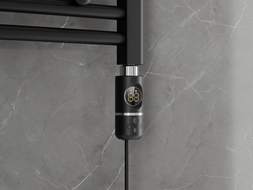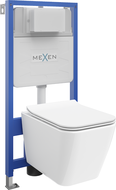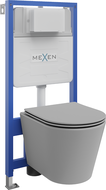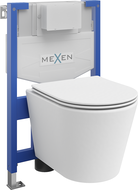
Wall-mounted toilet bowls are currently the most popular solution in Polish homes. Thanks to their modern design and smaller footprint, they have effectively dethroned traditional floor-mounted toilets. However, it is not just these features that have made them so popular. The concealed cistern hidden in the wall allows for better noise insulation from the flush, makes cleaning the floor easier, and protruding pipes no longer have to spoil the look of the bathroom. Read our article and find out how to properly install a concealed toilet cistern.
Which cistern should you choose?
When choosing a concealed toilet cistern, pay attention to ensure it is suitable for the type of wall you have in the designated toilet area. Concealed cisterns can be divided into two main types. For masonry walls, you can choose a heavy-duty cistern designed specifically for them. It is slightly heavier because the load mostly rests on the masonry walls. During installation, it is surrounded by bricks on the sides and bottom. However, remember that you can also choose a lightweight cistern, as it has universal applications.
More often than not, it is necessary to use a lightweight cistern. It is used when the installation of the concealed set takes place on gypsum board walls. This is somewhat more expensive, but it ensures that the final structure is very stable. It is screwed to the floor, so its weight mostly rests on the substrate. Before proceeding with the installation of the concealed toilet cistern, it is worth finding out how to do it properly.
Before you install a concealed cistern
An important step before installing a concealed toilet cistern is to plan the work properly and take accurate measurements. The cisterns typically occupy about 40 cm in width and 120 cm in height. Their thickness is about 20 cm. Additionally, there is the size of the ceramic bowl, which is generally about 40 cm wide and about 60 cm long. Perform the installation of the concealed cistern after analyzing whether using the toilet will be comfortable after the installation is complete.
The short time required for the installation is mainly determined by sanitary connections and sewer pipes. Special attention should be paid to properly executing this stage of work. The location where you install the cistern is determined by the position of the waste drain pipe for the toilet. In blocks, there is often a complicated network of pipes, which can complicate the installation of the concealed cistern. It may be advisable to hire a professional to connect the toilet to the stack in such situations. Usually, installation is not particularly troublesome. However, it is necessary to use the toilet connection to the stack using plastic pipes. Metal sheathed hoses are not suitable for this purpose.
Remember that if the drain is located on the side of the cistern, the distance of the toilet from the wall may change. Concealing the cistern in this case will limit the bathroom space. A flexible drain pipe for the toilet may prove helpful. It will assist in proper drainage direction and save space.
Proper mounting to the wall
Only after ensuring that the pipes and drain have been properly installed do we screw the frame of the cistern and the flush tank to the wall and floor. A hose delivering the right amount of water is also necessary, as the flush tank usually has a capacity of around 6 liters. Pay attention to ensure that the toilet bowl is located about 40 cm above the floor of the room. This is particularly important if tiles have not yet been laid in your bathroom. Carefully measure the distance from the floor, as this will impact the comfort of using the toilet.
However, before installing the toilet bowl, you should adequately conceal the cistern. Use water-resistant drywall. You will recognize it by its characteristic light green color. Also, be sure to purchase the appropriate amount of metal profiles, liquid foil, screws, and quick-mount plugs. Pay attention to choose a concealed cistern compatible with the selected toilet bowl. Staff in a building materials store will certainly assist you with expert knowledge and help you select all the necessary accessories.
Concealing the toilet cistern – step by step
The first step in installing the concealed toilet cistern should be to create an appropriate structure from the profiles. Analyze how much space you need for the concealed toilet cistern. In small bathrooms or separate toilets, the installation is often expanded to the full width of the recess or room. This way, hard-to-clean and manage small spaces do not arise, and the bathroom looks aesthetically pleasing and modern. Secure the wall profiles with mounting plugs.
Remember to tighten the drywall properly. You need to drill holes in the panels for the flush button, drainage, and the pipe supplying water from the flush tank. It is best to use a hole saw for cutting holes. Concealed cisterns usually come with templates that facilitate this task. Also, ensure the fastening plugs are prepared properly at the toilet bowl installation site. Next, screw the panels to the concealed toilet cistern and to the constructed profile structure. Use the appropriate types of screws for this. Many people decide to use two layers of drywall, each 12.5 mm thick, which significantly increases the strength of the finished structure and reduces the risk of cracking the ceramic coating.
Placing soundproofing tape under the profiles and the wall will minimize wall vibrations. This will enhance the comfort of using the toilet and provide better acoustic insulation. At the joints of the panels, it is also worthwhile to use sealing tape, and the entire structure should be painted with liquid foil.
You can finish the structure in any way you choose. Considering the conditions in the bathroom, we often decide on ceramic tiles. In many bathrooms, the area around the cistern is covered with a different type of tile than the rest of the room. This looks very favorable and allows for the separation of the toilet area, which enhances privacy. The decision to separate the toilet area with a partition wall also supports this aspect. Before laying the tiles, be sure to prime the panel surfaces.
After finishing the wall and grouting the tiles, you can install the toilet bowl. Fit it with the factory-prepared holes for the bolts, tighten it, and level it after checking the tightness. After completing the installation, place the toilet seat and flush button in the proper place. The last step will be to apply silicone sealant where the toilet meets the tiles.























